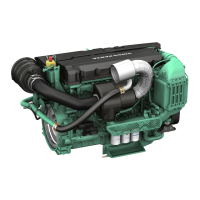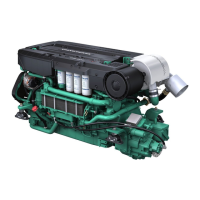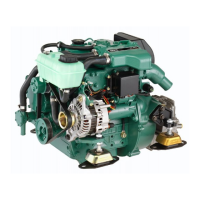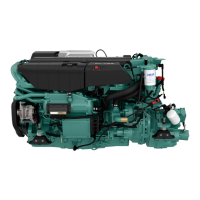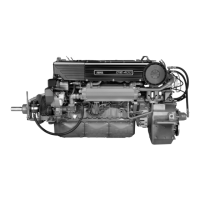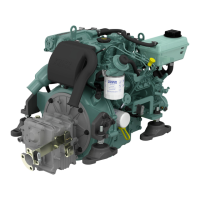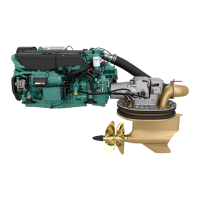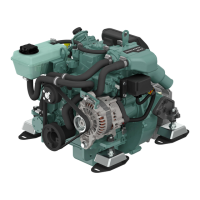Do you have a question about the Volvo Penta D13-400 and is the answer not in the manual?
Explains safety symbols (DANGER, WARNING, CAUTION, IMPORTANT, NOTICE) and their order of priority.
Covers safe engine operation, daily checks, maneuvering, and fuel filling precautions.
Details the risk of carbon monoxide poisoning and preventative measures.
Covers safe practices for maintenance, engine shutdown, and fire/explosion hazards.
Details risks associated with fuel, oil, batteries, and flammable materials.
Covers safety for hot surfaces, chemicals, cooling, lubrication, fuel, and electrical systems.
Details the components and functions of the MCC system for engine monitoring.
Description of the Marine Control Unit (MCU) panel and its buttons/indicators.
Explains the display elements and engine status indicators on the MCU panel.
Explains Local, Operations (PRP), and Off modes for engine control.
Describes the appearance and content of the alarm list shown on the display.
Essential checks and actions to perform before starting the engine.
Step-by-step guide on how to start the engine and verify its status.
Procedures for acknowledging and responding to audible and visual alarms during operation.
Steps for stopping the engine normally and checking its status.
How to perform an emergency stop and reset the system afterwards.
How the system warns the driver of malfunctions and provides guidance.
Steps to acknowledge and clear active alarms from the system display.
Explanation of the alarm list structure, headings, and alarm status indicators.
Information specific to the ECU alarm list and its fault codes.
Describes fault codes related to battery voltage and coolant levels.
Explains fault codes concerning engine oil level and pressure issues.
Covers faults related to auxiliary supply, communication failures, and throttle demand.
Details fault codes associated with low fuel pressure and system issues.
Faults related to high coolant temperature and low reverse gear oil pressure.
Faults related to low engine oil pressure and primary battery status.
Faults causing engine shutdown and issues with seawater pressure.
Covers miscellaneous system faults and engine derate alarms.
Faults related to SDU system failures and engine underspeed conditions.
Explains safety symbols (DANGER, WARNING, CAUTION, IMPORTANT, NOTICE) and their order of priority.
Covers safe engine operation, daily checks, maneuvering, and fuel filling precautions.
Details the risk of carbon monoxide poisoning and preventative measures.
Covers safe practices for maintenance, engine shutdown, and fire/explosion hazards.
Details risks associated with fuel, oil, batteries, and flammable materials.
Covers safety for hot surfaces, chemicals, cooling, lubrication, fuel, and electrical systems.
Details the components and functions of the MCC system for engine monitoring.
Description of the Marine Control Unit (MCU) panel and its buttons/indicators.
Explains the display elements and engine status indicators on the MCU panel.
Explains Local, Operations (PRP), and Off modes for engine control.
Describes the appearance and content of the alarm list shown on the display.
Essential checks and actions to perform before starting the engine.
Step-by-step guide on how to start the engine and verify its status.
Procedures for acknowledging and responding to audible and visual alarms during operation.
Steps for stopping the engine normally and checking its status.
How to perform an emergency stop and reset the system afterwards.
How the system warns the driver of malfunctions and provides guidance.
Steps to acknowledge and clear active alarms from the system display.
Explanation of the alarm list structure, headings, and alarm status indicators.
Information specific to the ECU alarm list and its fault codes.
Describes fault codes related to battery voltage and coolant levels.
Explains fault codes concerning engine oil level and pressure issues.
Covers faults related to auxiliary supply, communication failures, and throttle demand.
Details fault codes associated with low fuel pressure and system issues.
Faults related to high coolant temperature and low reverse gear oil pressure.
Faults related to low engine oil pressure and primary battery status.
Faults causing engine shutdown and issues with seawater pressure.
Covers miscellaneous system faults and engine derate alarms.
Faults related to SDU system failures and engine underspeed conditions.
| Engine Model | D13-400 |
|---|---|
| Cylinders | 6 |
| Power Output | 400 hp |
| Aspiration | Turbocharged and Intercooled |
| Displacement | 12.8 L |
| Fuel System | Common Rail |
| Cooling System | Freshwater cooled |
| Bore | 131 mm |
| Stroke | 158 mm |
| Emissions Compliance | IMO Tier II |
| Engine Category | Marine |
| Engine Type | In-line 6-cylinder diesel engine with common rail injection system, turbocharger, and air cooler |
